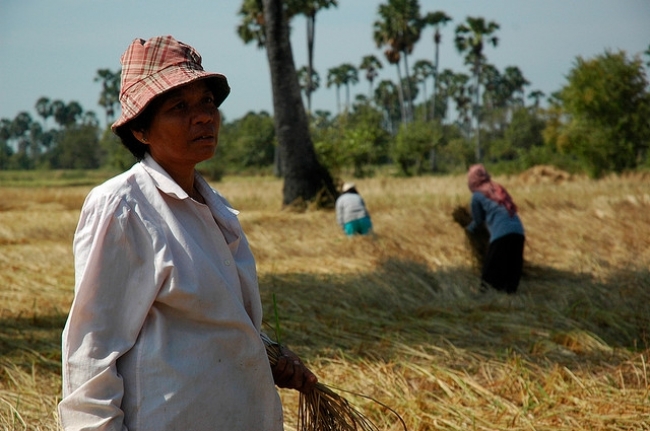
CAMBODIAN RICE FARMER, Marie, is participating in a field trial that should enable her and her fellow farmers to grow more rice while saving money and resources that can be invested in other crops. (Photo: Lehame Fountain)
Every year since 1995, Cambodia has produced a rice surplus. It is an impressive record given the agricultural devastation wrought by the violence of the 1970s. Yet many Cambodian rice farmers still harvest yields of only 2 tons per hectare, barely enough to feed their own families. Rice is the most important source of income and employment for rural Cambodians, and the source of around three- quarters of the average Cambodian’s calories. Productivity gains in rice, more than in any other crop, will therefore help reduce poverty.
One of the proven routes out of poverty is income diversification— if the rural poor can make money from a number of enterprises, not only does this provide extra income, but it also offers them a buffer when things go wrong, such as crop failure.
Moreover, rice farmers perched on the edge of self-sufficiency are denied the chance to improve their lot. They are forced to devote all their energies to rice just to stave off hunger for themselves and their families. In short, better rice production opens the door to more lucrative farming.
A short drive out of the Cambodian capital Phnom Penh, Preap Visarto, head of the Plant Protection Program at the Cambodian Agricultural Research and Development Institute (CARDI), and International Rice Research Institute (IRRI) Senior Scientist Gary Jahn are conducting the Farmstead field trial, a 3-year project supported by the Australian Centre for International Agricultural Research (see Forging partnerships in agricultural research). Farmstead consists of around 6 hectares of rice fields in a relatively favorable rainfed environment. Standing for “Fish and Rice Management System to Enable Agricultural Diversification,” the project fields are located by a canal that can provide supplemental water to nearby fields, although not enough to grow a fully irrigated dry-season rice crop.
Farmstead aims to help farmers intensify their rice production, thereby allowing the small amount of extra water, land and other resources consequently freed up to be invested in growing other crops, which can provide supplementary income for farmers. In addition, the project aims to design systems of intensification that complement, rather than hinder, rice field fish farming, an important source of income and protein for many farm families in this region.







